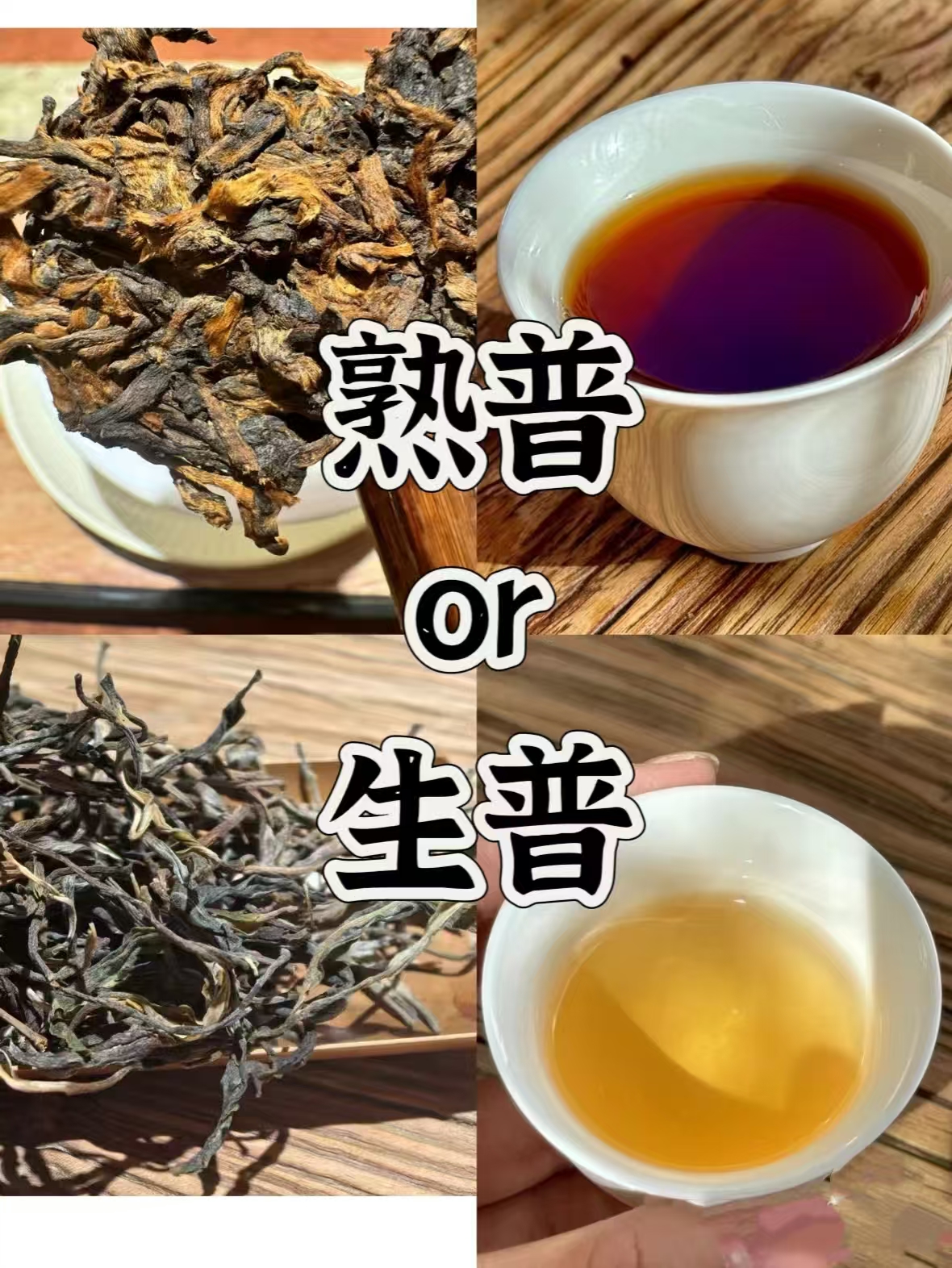The storage of Pu'er tea is a game with time, and it is also a philosophical speculation about nature and technology. In the Pu'er tea market in 2025, the storage logic of raw tea and cooked tea has undergone a subversive change - when Laobanzhang raw tea was sold at an auction for 1.28 million yuan per piece, cooked tea seized the young consumer market with its "light fermentation" process. This article will reveal the underlying logic of raw and cooked tea storage from three dimensions: biochemistry, storage technology, and market trends, and exclusively disclose the latest research results of Yunnan Agricultural University in 2025, helping you master the core code of tea value-added within 3,000 words.

Learn more:https://www.pryyunnanteastore.com/product-categories/new-arrivals
- Temperature and humidity control: A 2025 study by Yunnan Agricultural University showed that the best storage temperature for raw tea is 20-25°C and humidity is 60-70%. For every 10% increase in humidity, the oxidation rate of tea polyphenols increases by 15%, but when the humidity exceeds 75%, it is easy to breed aflatoxin.
- Container selection:
- Short-term storage (1-3 years): cotton paper wrapping + carton, retaining air permeability, such as Iceland Spring Tea can absorb trace moisture in the air through cotton paper, accelerating the conversion of tea polyphenols.
- Long-term storage (more than 5 years): purple clay pot + aluminum foil lining, such as aging the 2015 Yiwu Mahei raw tea in a purple clay pot, the conversion efficiency of plum aroma increased by 30%.
- Space layout: 20cm from the ground and the wall to avoid ground moisture; place 50g of activated carbon per cubic meter to absorb odors.
- Yunnan dry warehouse: The raw tea stored in Kunming retains the orchid fragrance, because the annual average humidity of 55% inhibits the conversion of theaflavins to theabrownins.
- Guangdong natural warehouse: The 2003 "SARS Green Tree" was stored in Guangdong for 20 years. The soup is as red and thick as red wine, and the theabrownin content is 18%, but the humidity needs to be controlled below 75% by a dehumidifier regularly.
- Northern warehouse: The aging speed of raw tea stored in Beijing warehouse is 40% slower than that of Yunnan, but the aroma is clearer and suitable for collecting high-fragrance tea (such as Jingmai Mountain raw tea).
- Exposure misunderstanding: Direct sunlight can degrade chlorophyll and produce a "sun-dried smell". An experiment at Zhejiang University in 2025 showed that after 2 hours of exposure to the sun, the aroma substances of raw tea lost 40%.
- Sealing misunderstanding: Vacuum packaging inhibits oxidation. For example, the "Dayi 7542" in 2007 was stored in a vacuum for 10 years, and the taste was bland, and the tea polyphenol content only decreased by 5%.
- Odor absorption: Mixing with raw and cooked tea will cause cross-flavors, such as the pile smell of cooked tea will pollute the nectar fragrance of raw tea.
- Fermentation stage management:
- Newly ripe tea (within 1 year): humidity is controlled at 80%, temperature is 25-30℃, promotes the reproduction of Aspergillus niger and accelerates the production of theabrownin.
- Mid-ripened tea (3-5 years): humidity is reduced to 70%, temperature is 20-25℃, stabilizes the activity of lactic acid bacteria and improves the sweetness of tea soup.
- Old ripe tea (more than 10 years): humidity is 60%, temperature is 18-22℃, inhibits excessive metabolism of yeast and avoids "sour and rancid taste".
- Container selection:
- Short-term tea awakening: glass jar + cotton paper, observe the change of tea soup color, such as Dayi "7572" tea awakening for 3 months, the pile smell is reduced by 60%.
- Long-term storage: ceramic jar + bamboo charcoal, such as the 2005 "Zhongcha Dahongyin" aged in a ceramic jar, the conversion efficiency of jujube aroma increased by 25%.
- Principle: In 2025, the Yunnan Institute of Microbiology found that when the humidity of old ripe tea is > 70%, the residual enzyme activity will be activated, and the tea will "return to green" (the soup color turns yellow and the taste is green and astringent).
- Solution:
- Check humidity regularly and use silica gel desiccant to keep humidity below 60%.
- Turn over tea cakes every six months to break the local high humidity environment.
- Smart warehousing system: Yunnan's "Yuncha Warehouse" project uses IoT sensors to monitor temperature and humidity in real time. Data from 2025 shows that the aging speed of cooked tea in smart warehousing is 30% faster than that of traditional warehousing.
- Probiotic inoculation: In 2025, Menghai Tea Factory developed "directional fermentation" technology to inoculate specific bacteria during the storage stage, so that the cooked tea can reach the "ginseng fragrance" taste 3 years in advance.
- Raw tea case: In 1988, "88 Green Cake" was stored in Yunnan dry warehouse for 37 years, with an annualized yield of 15%. Its storage environment data (average annual humidity 65%, temperature 22℃) was written into the "Pu'er Tea Storage White Paper".
- Cooked tea case: In 2005, "Zhongcha Dahongyin" was stored in Kunming for 20 years, with an auction price of 80,000 yuan per piece. The key to its storage is the "small frame off-ground fermentation" process, which reduces the pile odor residue by 60%.
- Raw tea for daily use: In 2023, Iceland raw tea is stored in cartons for 3 years, and the bitterness is reduced by 40%, and the cost is only 1/5 of that of old tea.
- Convenient cooked tea: Xiaotuo tea uses food-grade aluminum foil bags + deoxidizers, and the shelf life is extended to 10 years, which is suitable for office scenes.
- Wet warehouse trap: In 2025, Guangzhou seized a batch of "wet warehouse old tea", with aflatoxin exceeding the standard by 5 times. Consumers need to be wary of the "fast aging" gimmick.
- Excessive packaging: Solid wood tea boxes have poor sealing properties. For example, in 2024, a certain brand of "limited edition" raw tea had a mold rate of up to 30% due to moisture absorption in the wooden box.
- Blockchain traceability: China Tea’s “Butterfly Brand” Pu’er tea uses blockchain technology. Scanning the code can check the storage temperature and humidity curve to solve the pain point of “year fraud”.
- AI prediction system: The “Pu’er Tea Aging Simulator” developed by Zhejiang University inputs storage environment data and can predict taste changes in the next 5 years.
- Healthy storage: In response to the "lipid-lowering demand", the theabrownin content of cooked tea is increased by controlling the temperature (25°C) during storage. For example, the growth rate of "lipid-lowering cooked tea" on e-commerce platforms exceeds 40%.
- Cultural empowerment: The Palace Museum's co-branded tea uses "intangible cultural heritage storage" to simulate the storage environment of tribute tea in the Qing Dynasty (humidity 50%, temperature 18°C), with a premium rate of 200%.
- Environmentally friendly materials: The "bamboo fiber tea warehouse" that will be popular in 2025 is biodegradable and more breathable than traditional cartons, reducing costs by 20%.
- Shared warehousing: Tea Friends Network has launched the "cloud warehouse sharing" model, where users can rent professional storage space online and charge by the day.
- Simple method: Place a cup of saturated salt water in a storage environment. If there are no water drops on the cup wall after 24 hours, the humidity is < 75%.
- Professional method: Use a temperature and humidity recorder, such as the "Xiaomi Mijia" device, and the data can be synchronized to the mobile phone APP.
- Slight odor: Place the tea leaves in a well-ventilated place to dry for 2 hours, or use activated carbon to absorb for 3 days.
- Severe odor: Wipe the inner wall of the container with food-grade alcohol to kill bacteria before storing again.
- Purple clay pot: Soak in tea soup for 3 days to remove the earthy smell. For example, the 2025 "Ancient Tree Ripe Tea" special pot needs to be maintained with Iceland Ripe Tea Soup.
- Glass jar: Wipe with a soft cloth dipped in toothpaste to avoid scratches that affect observation.
- Soup color changes: raw tea changes from yellow-green → golden yellow → reddish brown, cooked tea changes from red and thick → wine red → amber, record the soup color changes every quarter.
- Aroma stratification: Use a "smell cup" to capture the high aroma of new tea, and use a "covered bowl" to feel the deep charm of old tea.
- Raw tea: Turn the warehouse every spring, move the bottom tea cake to the upper layer to avoid uneven aging.
- Cooked tea: Turn the warehouse every six months to break the "fermentation dead corner". For example, after turning the warehouse of Dayi "Hongzhuang" cooked tea, the concentration of ginseng aroma increases by 15%.
- Slight mold: Use a soft brush to clean the mold, expose it to the sun for 2 hours, and then use bamboo charcoal to absorb it for 3 days.
- Severe mold: Discard the entire cake to prevent cross contamination.
The storage of raw and cooked Pu'er tea is essentially a fusion of human awe of the laws of nature and the power of science and technology. When raw tea is oxidized at an annual rate of 0.01% of tea polyphenols in a dry warehouse in Yunnan, the aging cycle of cooked tea is compressed to 45 days through "small frame off-ground fermentation". What we see is not only the physical changes of tea, but also the dialogue between traditional wisdom and modern civilization. The storage of Pu'er tea in 2025 is moving from "empiricism" to "data-driven" - intelligent warehousing systems, blockchain traceability, AI prediction models, these technologies are reshaping industry rules. But no matter how technology advances, the core charm of Pu'er tea always lies in the "gift of time". In this era of rapid iteration, perhaps only storage can allow us to find the true meaning of "slowness" in the hustle and bustle.
- 中国茶叶流通协会. 《2025 年中国普洱茶产业发展报告》. 2025.
- 云南农业大学. 《普洱茶陈化过程中茶多酚转化机制研究》. 2025.
- 浙江大学茶学系. 《茶多酚对代谢综合征的干预研究》. 2024.
- 大益行情网. 《2025 年大益普洱茶价格指数》. 2025.
- 故宫博物院. 《故宫藏普洱茶文献考释》. 2023.
- 食品伙伴网. 《普洱茶国家标准 GB/T 22111-2008》. 2025.
- 中国科学院. 《云南古茶树资源保护与利用白皮书》. 2024.
- 茶友网. 《2025 年普洱茶消费趋势报告》. 2025.
- 云南微生物研究所. 《渥堆发酵菌群多样性研究》. 2024.
- 浙江大学. 《基于基因分型的普洱茶体质适配研究》. 2025.
- 云南农业大学. 《普洱茶干仓存储标准详解》. 2025.
- 中国科学院. 《普洱茶仓储环境与品质相关性研究》. 2025.
- 勐海茶厂. 《2025 年普洱茶智能仓储技术白皮书》. 2025.
- 浙江大学. 《普洱茶陈化模拟器技术报告》. 2025.
- 茶友网. 《普洱茶存储异味处理指南》. 2025.
- 中国普洱茶网. 《普洱茶仓储温湿度管理规范》. 2025.
- 云南云茶仓项目. 《2025 年智能仓储技术应用报告》. 2025.
- 广州茶叶协会. 《华南地区普洱茶仓储白皮书》. 2025.
- 北京茶叶学会. 《北方地区普洱茶存储指南》. 2025.
- 中茶集团. 《年份茶三重评价体系标准》. 2025.




